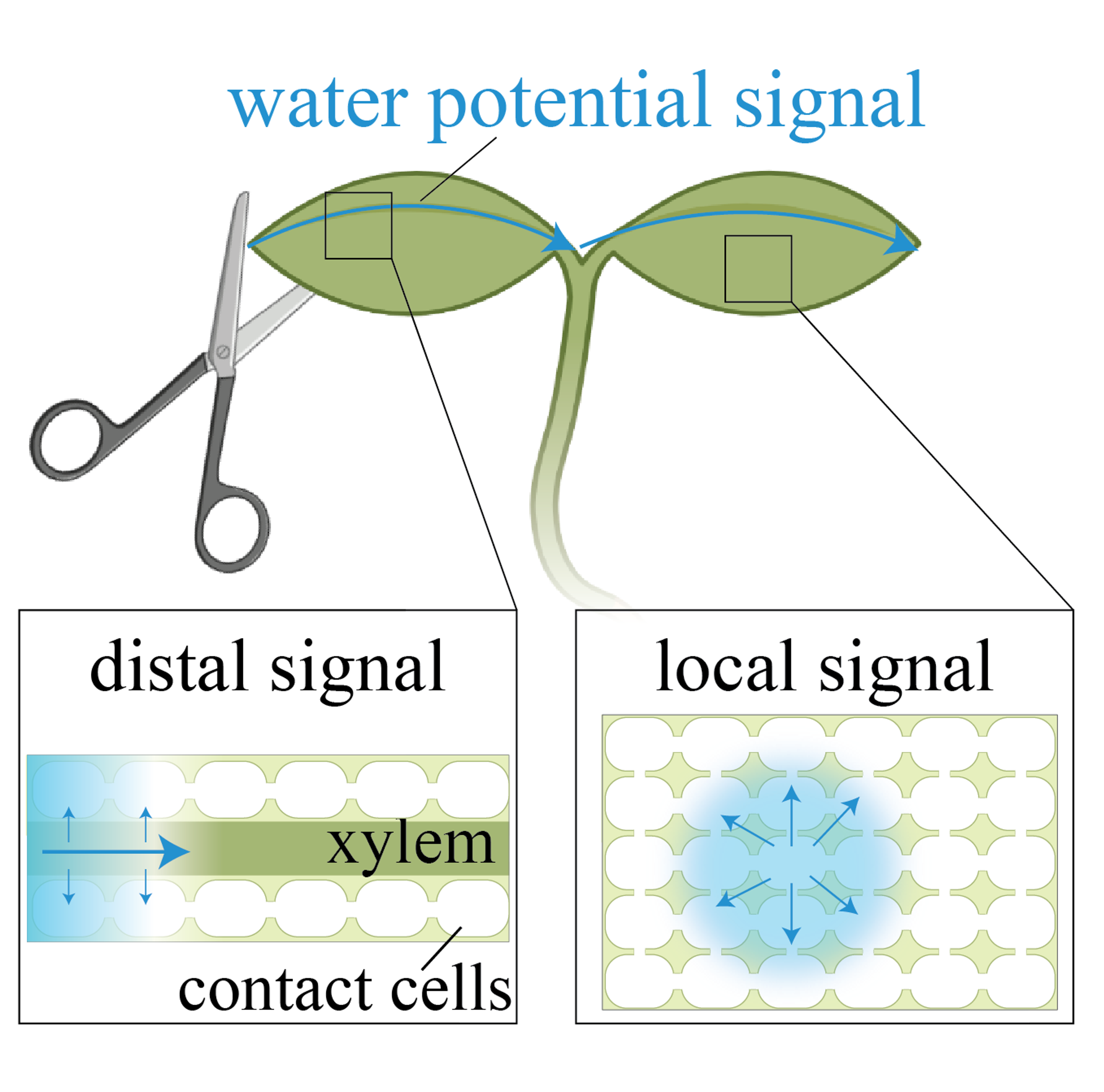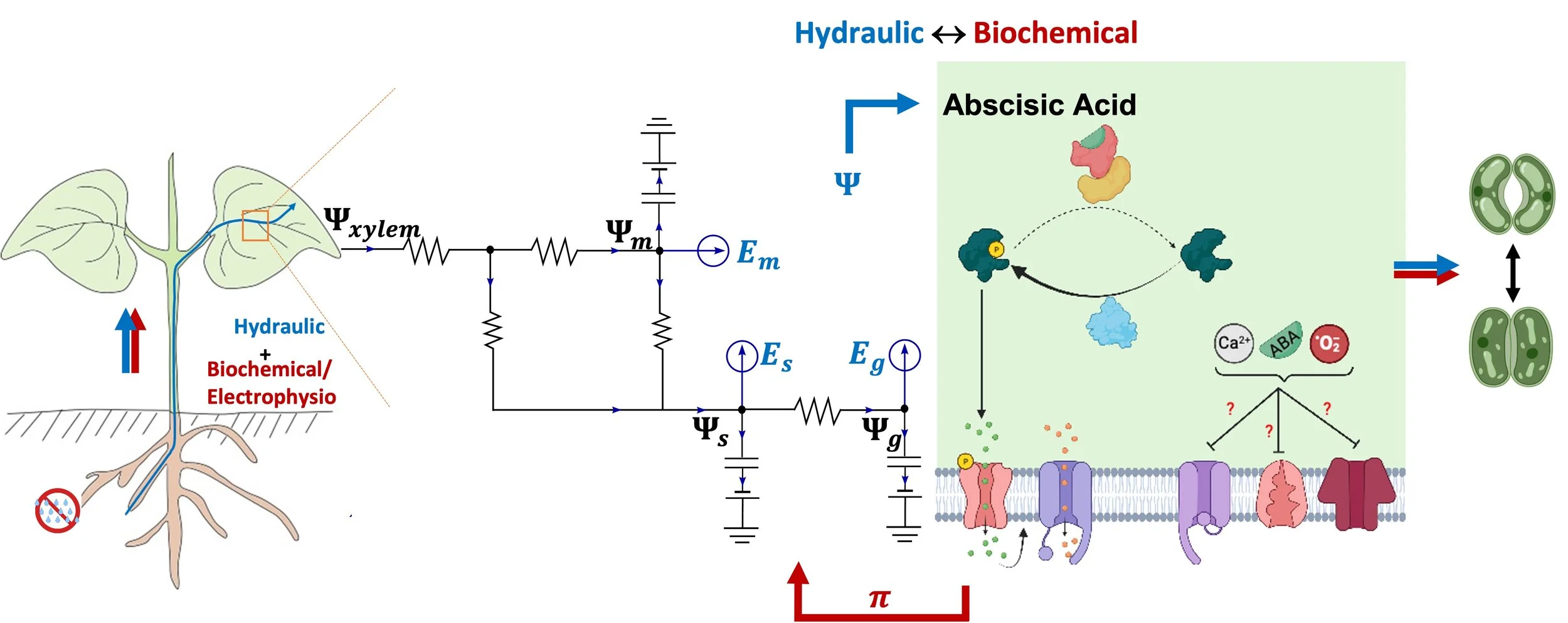
Research
Current Projects
Hyper-local measurements of leaf water relations.
Plant leaves support critical biological functions and play a dominant role in mediating land-atmosphere exchanges of water, CO2, and energy (Figure). Leaves are also the terminus of the hydraulic path for transpiration from soil to the evaporative surfaces in the spongy mesophyll beneath the epidermis and stomata. To date, plant physiologists have treated the tissues separating the vessels (xylem) from the sites of evaporation as passive regulators of transfer of water. We are using a technology developed in our lab, AquaDust (Jain et al, PNAS, 2021), to elucidate the biophysics of this outside xylem zone (OXZ) and the active biological regulation that it provides of transpiration. Our discoveries suggest new mechanisms by which plants can manage water stress and improve water-use efficiency.
Leads: Piyush Jain, Sabya Sen, and Annika Huber
Publications:
Jain, P., Liu, W., Zhu, S., Chang, C.Y.-Y., Melkonian, J., Rockwell, F.E., Pauli, D., Sun, Y., Zipfel, W., Holbrook, N.M., Riha, S.J., Gore, M.A. and Stroock, A.D., 2020. A minimally disruptive method for measuring water potential in-planta using hydrogel nanoreporters. Proc. Natl. Acad. Sci. 118 (23) e2008276118 (2021).
Rockwell, F.E., Holbrook, N.M., Jain, P., Huber, A.E., Sen, S., and Stroock, A.D. Extreme undersaturation in the intercellular airspace of leaves: a failure of Gaastra or Ohm? Annals of Botany 130, 301-316 (2022).
Jain, P., Huber, A.E., Rockwell, F.E., Sen, S., Holbrook, N.M. and Stroock, A., 2023. Localized measurements of water potential reveal large loss of conductance in living tissues of maize leaves. bioRxiv, pp.2023-06 (2023).
Funding: NSF CROPPS and AFOSR
Biophysical mechanisms of long-distance signaling in plants.
Spending their lives rooted in one place, plants exhibit remarkable adaptability in their metabolism and development in response to the changing environment. Plants coordinate these stress responses by sending signals throughout their tissues, from roots to canopy and from one leaf to all others. Despite significant work in this area over the past century, fundamental questions remain about the modes — chemical, electrical, mechanical — by which signals propagate over long distances in plants. In this collaborative project within the CROPPS Center, we are building mathematical models of these modes of transmission, with a focus on the coupling of fluid mechanical processes with biochemical and mechanobiological responses. In parallel, we are developing and applying gene-encoded and synthetic reporters to track the real-time signal dynamics with the goal of elucidating the biophysical, biochemical, and genetic bases of long-distance signaling. On these foundations, we aim to develop sophisticated sentinel plants that can report and respond to above- and belowground stress for applications in research and agriculture.
Leads: Vesna Bacheva & Annika Huber
Publications:
Comtet, J., Turgeon, R. & Stroock, A.D., Phloem loading through plasmodesmata: a biophysical analysis. Plant Physiology, 175, 904-915 (2017).
Comtet, J., Jensen, K., Turgeon, R., Stroock, E.D. & Hosoi, A. Passive phloem loading and long-distance transport in a synthetic tree-on-a-chip. Nature Plants, 3, 17032 (2017).
Funding: NSF CROPPS
Systems biology of stomatal regulation of water stress.
The changing climate increases the magnitude and uncertainty of water stresses experienced by plants in agriculture and natural ecosystems. Existing frameworks for modeling plant responses to these stresses do not adequately account for the coupling of physical and biological processes and these deficiencies hinder the pursuit of genetic hypotheses and compromise the robustness of predictions. We are developing a systems biology framework of stomatal regulation that helps understand plant response to drought conditions. We aim to use the systems biology model to guide the design of new genetic variants with interesting phenotypes with respect to water and carbon dioxide regulation and to form the basis of mechanistic models within plant in-silico models.
Lead: Sahil Desai
Funding: NSF CROPPS


